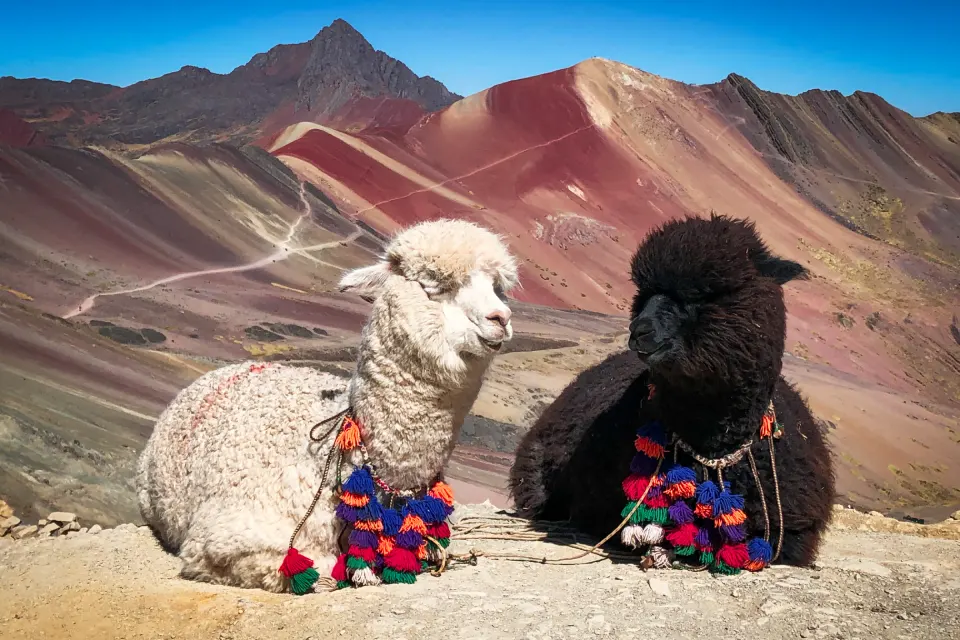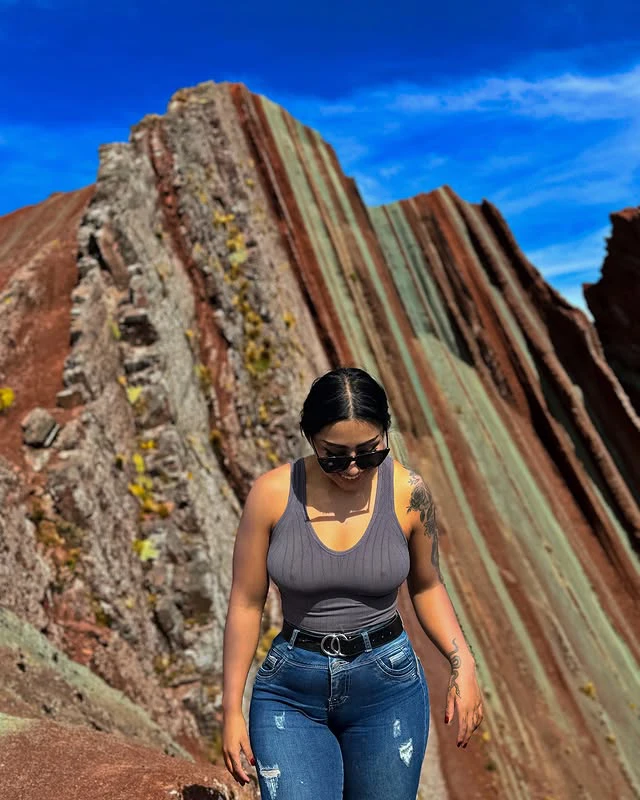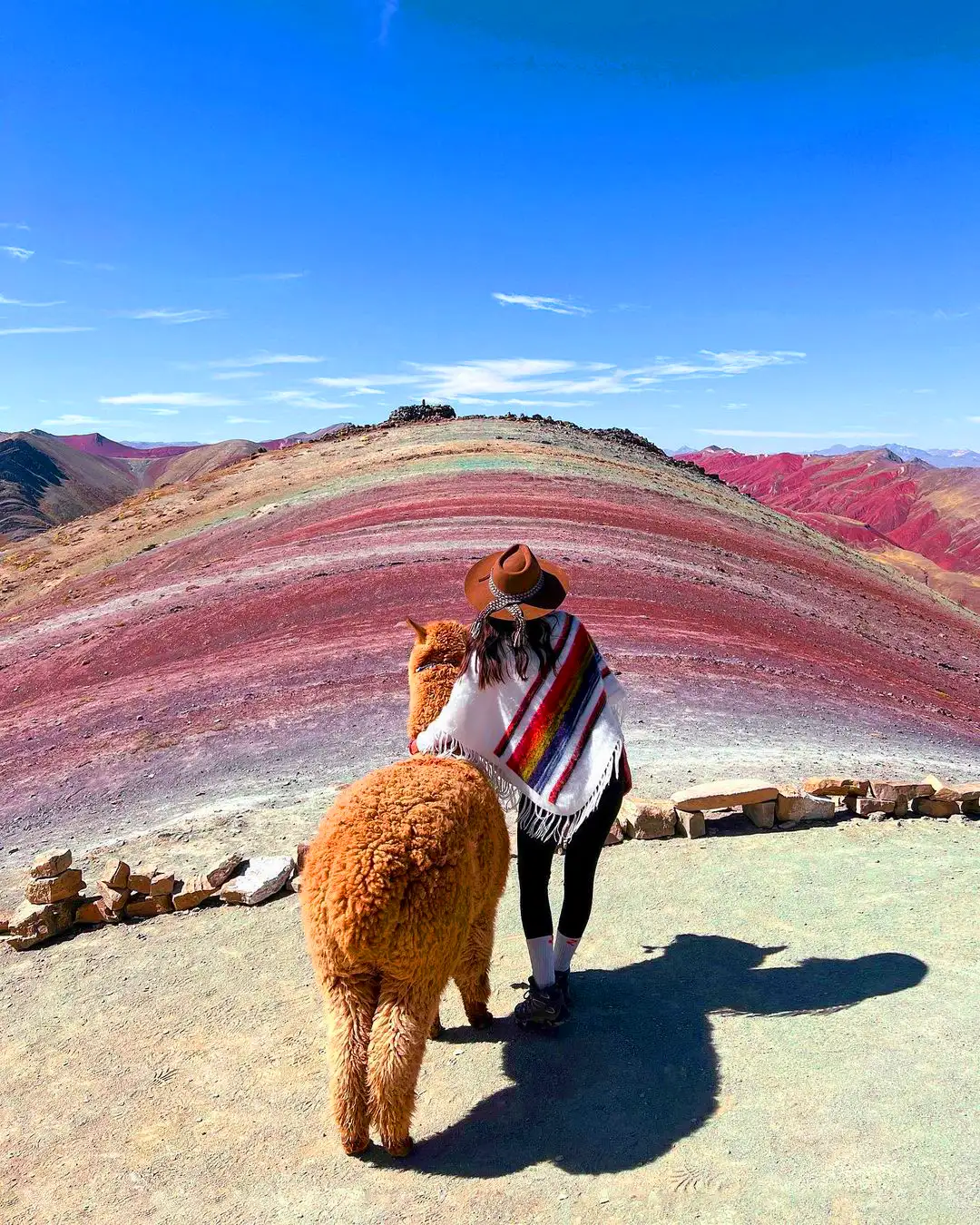The Rainbow Mountain, also known as the Mountain of the Seven Colors or Vinicunca, is located southeast of the city of Cusco, in the Vilcanota mountain range. This recent name, originally from Quechua, refers to the colors present on its slopes. Visitors from all over the world often ask themselves: Why is the Rainbow Mountain Peru colorful?
Its varied tone is the result of a complex mixture of different minerals. Since 2016, it has become one of the country's main attractions, along with Machu Picchu and all Peruvian cuisine.
The origin of the Rainbow Mountain
To discuss its history, we should allude to its geological structure, which originates from the accumulation of river, lake, and marine elements over a long period. The minerals carried by the mountain range's waters for centuries, added to the humidity and winds, have caused a unique oxidation that has given the mountain its varied color.
Specialists in geological phenomena of this nature have determined that this mountain of amazing colors was discovered thanks to the melting of the glaciers that previously covered it. It still received snow until the nineties of the last century.
Its cultural relevance lies mainly in its rather peculiar features, which have led to scientific analysis, and what, in its current state, it meant for the indigenous residents of the region before the arrival of the Spanish.
The mineralogical composition that underlies its colors
According to research that has been done with soil samples that make up Rainbow Mountain, it has been seen that the colors that form it are given thanks to precise minerals that produce its characteristic shades. Among these are:
- White: This color originates thanks to the limestone and quartz sand that was found in the samples.
- Pink: It arises from the combination of red clay, sand, and shale.
- Red: A prevalent clay color composed of quartz, mica, and sericite.
- Lavender or purple: This hue arises from the composition of clay and calcium carbonate in the marl, which, together with the silicates, gives rise to the mountain's symbolic purple color.
- The yellow, mustard, or golden hue: is due to the limonite and sulfurous minerals contained in the calcareous sandstones.
- Of earthy tone: Generated by manganese rocks that belong to the quaternary stage, it gives this tone thanks to the accumulation of this type of rock.
- Green: The clays are abundant in iron and magnesium minerals, and the copper oxide results in this color.
So, why is Rainbow Mountain Peru colorful?
Its intriguing shades are the result of long and very particular geological processes and the wide variety of minerals that the earth, which composes it, houses. Each layer has its particularities in terms of color, mineral composition, and temperature.
It includes the Vilcanota mountain range, which is also located in the area where the Ausangate snow-capped mountain is located. It took millions of years to create, during which time it went from being an area covered by glacial, lake, and sea waters that carried a variety of sediments to a rocky consolidation of these sediments.
Erosion and earth movements took care of sculpting it and giving it its exceptional and beautiful colors. Residents of nearby areas claim that it was somehow discovered between 2015 and 2016. Since then, it has been widely photographed and shared on social media, which is reason enough to start attracting thousands of visitors from all over the world.
Information about altitude and the complexity of reaching Vinicunca
Understanding this natural wonder known as Vinicunca or Rainbow Mountain requires you to plan your trip in detail. It is important to remember that you will be at an altitude of 5,036 meters (16, 522 feet)above sea level, which means that your hike will take you at least four hours round trip.
This hike may be a great challenge for you, but we have already pointed out that you can do the tour on horseback or a four-wheeler. In any case, it will be an unforgettable experience for you to witness so much natural color in one of the most majestic places in the world and interact, while traveling the road, with the inhabitants of the region, where you will be able to come into contact with their traditions and customs from the moment you begin your trip in Cusco.
Climate in the Rainbow Mountain or Vinicunca
Temperatures
- Early Morning: The temperature during the early morning is very cold, ranging between 26°F and 32°F (-3°C to 0°C)
- Daytime: With the sunrise, temperatures typically range from 41°F to 68°F (5°C to 20°C), with July and August being the coldest months.
- Nighttime: At night, temperatures drop again, ranging from 32°F to 50°F (0°C to 10°C).
Rainy season
The rainy season in Cusco runs from November to March. During these months, the terrain is usually covered with mud and mud, so it is essential to wear sturdy hiking boots to avoid falls or slips. It is also recommended to carry a rain poncho to keep dry. Due to the constant rains and cold, Colored Mountain can sometimes transform into a “white Mountain” covered in snow.
Dry season
The dry season occurs between April and October, with almost no rainfall. During these months, the terrain is stable and easier for travelers to traverse. The sun enhances the colors of the mountain, offering a visual spectacle for visitors.
Finally... What is the best time to visit Rainbow Mountain?
First, remember that the best time of year to visit Rainbow Mountain is during the dry season, which runs from April to November. In particular, during the months of April and May or between September and November, because during these periods, the weather is more favorable and there are fewer visitors.
Regarding the hours of the day to walk, it might be more convenient in the morning, from seven to nine, leaving Cusco between three and four. In the afternoon, after two o'clock, you will have the advantage of having fewer people walking, and you will be able to enjoy it with more serenity.
⏭️Read more: How to Get to Rainbow Mountain in Peru
Alternatives to Rainbow Mountain
Pallay Punchu
The Pallay Punchu Colored Mountain was recently discovered during the pandemic and has become a unique destination in the Cusco Andes. Located in the south of the Cusco region, in the province of Canas, district of Layo, this mountain is also known as the “Colored Sharp Mountain” due to its sharp peaks and shades.
Pallay Punchu is part of the Apu Taqllo Apacheta mountain, and its name comes from Quechua, where “Pallay Punchu” means “adorned poncho”. This name refers to its appearance, which shows an Andean poncho woven with traditional colors. Despite its beauty, it remains an uncrowded destination, ideal for those seeking tranquility away from the crowds.
Palcoyo mountain
Palcoyo is another colorful mountain in the Vilcanota range, located in the Checacupe district of Cusco, at 4,900 meters above sea level. It's not far from the impressive Ausangate, one of the highest peaks in the region.
Unlike Vinicunca, Palcoyo is easier to reach and involves a gentler hike. During your visit, you’ll see several rainbow-like mountains, the unique Stone Forest (Bosque de Piedras), local wildlife like alpacas and vicuñas, and breathtaking views of Ausangate in the distance.
⏭️Read more: Vinicunca vs Palcoyo
Red Valley
Located just 3 hours from Cusco and 7 kilometers from the district of Pitumarca, in the province of Canchis, this valley is close to the 7 Colors Mountain and the majestic Apu Ausangate. The Red Valley is an exceptional landscape, known for its reddish tones, a product of the oxidation of iron in the rocks over thousands of years.
This destination is often included as a complement to the 7 Colors Mountain tour, as it is only 20–30 minutes away.
Humantay Lake
The Humantay Lagoon is the third most visited tourist attraction in Cusco, after Machu Picchu and the Rainbow Mountain. It is located in the community of Soraypampa, at an altitude of 4,200 meters above sea level.
The name Humantay comes from two Quechua words: “huma”, which means “head”, and “antay”, which translates as “sacred”. Its turquoise waters, surrounded by the Humantay mountain, make this place a must-see destination.
Now that you know why Rainbow Mountain Peru is colorful, plan your visit and uncover the fascinating colors along with the scientific explanation behind this natural masterpiece. If you don't have a lot of time, join our full-day tour, but if you have more time to spare, choose one of our packages that includes destinations like Humantay Lake and Machu Picchu.


















Add new comment